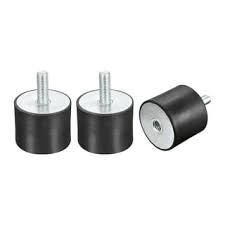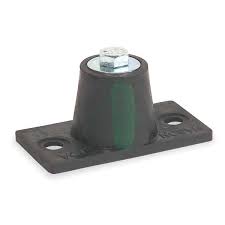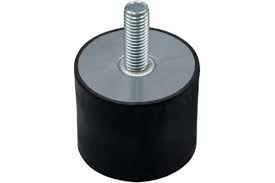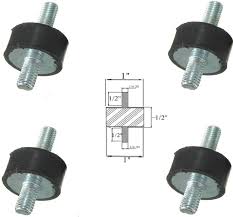HVAC vibration isolation systems are essential for maximizing comfort and efficiency in buildings. These systems play a crucial role in mitigating the disruptive effects of vibration and noise generated by HVAC equipment, ultimately enhancing the overall performance of heating, ventilation, and air conditioning systems. By effectively isolating and controlling the transmission of vibration, these systems contribute to a more comfortable and productive indoor environment while also extending the lifespan of the HVAC equipment. In this article, we will explore floor mount vibration isolators the importance of HVAC vibration isolation systems and the benefits they offer in optimizing the performance of building HVAC systems.
"HVAC Vibration Isolation Systems" are designed to reduce vibrations and noise caused by HVAC equipment, such as air conditioners and furnaces. These systems are typically used in commercial and industrial buildings to improve comfort for occupants and increase the efficiency and lifespan of the HVAC equipment. By maximizing comfort, HVAC vibration isolation systems can help create a more pleasant indoor environment for building occupants. Additionally, reducing vibrations and noise can also lead seismic base isolation to a quieter and more peaceful setting, which can be particularly important in settings such as offices, hospitals, and schools. In terms of efficiency, vibration isolation systems can help to prolong the life of HVAC equipment by reducing wear and tear caused by excessive vibrations. This can ultimately lead to cost savings by decreasing the need for frequent repairs and replacements. Overall, HVAC vibration isolation systems play a crucial role in creating a comfortable and efficient environment in commercial and industrial buildings.
HVAC vibration isolation systems are designed to minimize the transmission of vibrations and noise from heating, ventilation, and air conditioning (HVAC) equipment to the surrounding building structure. These systems typically consist of spring or rubber mounts that help absorb and dampen vibrations generated by HVAC units such as air handlers, chillers, and pumps. By reducing vibrations and noise, HVAC vibration isolation systems contribute to maximizing comfort for building occupants. Excessive vibrations and noise can be disruptive and seismic isolation bearings uncomfortable, so mitigating these factors can create a more pleasant indoor environment. Furthermore, these systems also contribute to the efficiency and longevity of HVAC equipment. By minimizing vibrations, vibration isolation systems help to protect the structural integrity of the building and prevent damage to the HVAC units, leading to reduced maintenance and repair costs. Additionally, they can also result in energy savings as smoother operation of the HVAC equipment typically leads to increased efficiency. In summary, HVAC vibration isolation systems are essential for enhancing comfort and efficiency in buildings by reducing noise and vibrations, protecting equipment, and improving the overall indoor environment.
Understanding the Importance of HVAC Vibration Isolation Systems

HVAC vibration isolation systems are crucial in preventing excessive vibrations and noise in HVAC equipment. These systems help to minimize the transmission of vibrations from the HVAC unit to the building structure, protecting both the equipment and the building itself. By reducing vibrations, they also help to prolong the lifespan of HVAC components, improve energy efficiency, and enhance indoor air quality. Properly installed vibration isolation systems can contribute to a quieter, more comfortable indoor environment, while also reducing maintenance and repair costs for the HVAC system.
Choosing the Right HVAC Vibration Isolation System for Your Needs

Choosing the right HVAC vibration isolation system involves several factors. These include the size and weight of the HVAC system, the type of vibration it produces, and the environment in which it will be installed. It is important to consider the specific requirements of your HVAC system and select a vibration isolation system that can effectively mitigate the vibration and minimize noise. There are different types of vibration isolation systems available, including spring isolators, neoprene pads, and elastomeric mounts. Each type has its own advantages and limitations, so it is essential to evaluate your specific needs and choose the most suitable option. In addition to the type of isolation system, you should also consider the installation and maintenance requirements. Some systems may require professional installation, while others can be easily integrated into your HVAC setup. It is crucial to ensure that the chosen vibration isolation system is compatible with your HVAC system and meets industry standards for performance and safety. Ultimately, selecting the right HVAC vibration isolation system will help to extend the lifespan of your HVAC equipment, reduce maintenance costs, and create a more comfortable and quiet environment. It is advisable to consult with an experienced HVAC technician or vibration isolation specialist to determine the best solution for your specific needs.
Benefits of Upgrading to a High-Quality HVAC Vibration Isolation System

Upgrading to a high-quality HVAC vibration isolation system can provide several benefits. These include improved energy efficiency, reduced noise levels, extended equipment lifespan, and minimized maintenance costs. Additionally, a high-quality vibration isolation system can enhance overall system performance and reliability, ensuring a more comfortable and productive indoor environment. Furthermore, it can help prevent expensive damage to the HVAC system and surrounding structures, ultimately saving money in the long run.
Common Mistakes to Avoid When Installing HVAC Vibration Isolation Systems

Some common mistakes to avoid when installing HVAC vibration isolation systems include: 1. Improper selection of vibration isolation components: It is crucial to select the right type and size of vibration isolators to effectively isolate the HVAC equipment from the building structure. 2. Inadequate installation: Ensure that the vibration isolation system is installed correctly according to the manufacturer's guidelines. Improper installation can lead to reduced effectiveness and potential damage to the equipment. 3. Ignoring maintenance: Regular maintenance of the vibration isolation system is essential to ensure its continued effectiveness. Neglecting maintenance can lead to premature failure and increased vibration transmission. 4. Underestimating the importance of professional expertise: It's important to involve experienced HVAC professionals in the design and installation of vibration isolation systems. They can provide valuable insights and ensure that the system is installed correctly. By avoiding these common mistakes, you can ensure that your HVAC vibration isolation system effectively reduces vibration transmission and minimizes noise in your building.
Maximizing Energy Efficiency with HVAC Vibration Isolation Systems
hvac vibration isolation
HVAC vibration isolation systems help to maximize energy efficiency by reducing the amount of energy that is wasted due to vibrations. Vibration isolation systems work by minimizing the transfer of vibrations from HVAC equipment to the building structure, which can cause energy loss and increase wear and tear on the equipment. By implementing vibration isolation systems, HVAC equipment can operate more efficiently and quietly, leading to lower energy consumption and reduced maintenance costs. Additionally, vibration isolation systems can help extend the lifespan of HVAC equipment, further maximizing energy efficiency over time. Overall, the use of vibration isolation systems in HVAC applications can contribute to significant energy savings and improved system performance.
Innovative Technologies in HVAC Vibration Isolation Systems
Innovative technologies in HVAC vibration isolation systems include the use of advanced materials such as neoprene, rubber, and polyurethane to effectively dampen and isolate vibrations generated by heating, ventilation, and air conditioning equipment. This helps reduce noise, improve system performance, and extend the lifespan of the equipment. Additionally, advancements in design and engineering have led to the development of highly efficient vibration isolation systems that can be customized to meet the specific requirements of different HVAC setups. These technologies play a crucial role in maintaining optimal working conditions in commercial and residential buildings by minimizing the impact of vibrations from HVAC systems.
Factors to Consider When Selecting HVAC Vibration Isolation Systems
- Weight and load capacity of the HVAC equipment - Frequency and amplitude of vibration - Size and dimensions of the equipment and the available space for installation - Environmental conditions and potential exposure to chemicals, moisture, or extreme temperatures - HVAC system requirements for noise and vibration control - Cost and budget for the isolation system - Ease of installation and maintenance - Compliance with building codes and industry standards - Availability of technical support and expertise from the manufacturer or supplier
Maintenance Tips for Keeping Your HVAC Vibration Isolation System Performing at Its Best
Regularly Inspect and Clean: Inspect your HVAC vibration isolation system for any signs of wear and tear, and be sure to clean the system regularly to remove any debris that can affect its performance. Check for Loose Components: Check for any loose bolts, nuts, or other components that may have become loose over time and tighten them as necessary to maintain proper function. Monitor for Excessive Vibration: Keep an eye on your HVAC system for any signs of excessive vibration, as this can indicate a potential issue with the vibration isolation system that needs to be addressed. Schedule Professional Inspections: It's important to have a professional inspect your HVAC vibration isolation system on a regular basis to ensure that it is performing at its best and to address any potential issues before they become bigger problems. Replace Worn Components: If any components of the vibration isolation system are worn or damaged, it's important to replace them promptly to ensure the system continues to perform effectively. Follow Manufacturer's Guidelines: Finally, be sure to follow the manufacturer's guidelines for maintenance and care of your HVAC vibration isolation system to ensure it continues to perform at its best.
In conclusion, HVAC vibration isolation systems are essential for maximizing comfort and efficiency in HVAC systems. These systems play a crucial role in reducing noise and vibrations, extending the life of equipment, and improving overall performance. By investing in high-quality vibration isolation systems, building owners and facility managers can ensure a comfortable and productive environment while also minimizing the risk of costly repairs and downtime.
See also
https://www.mcmaster.com/vibration-isolators https://www.reidpipe.com/vibration-isolation https://www.engineerlive.com/content/ultimate-vibration-isolation-guide